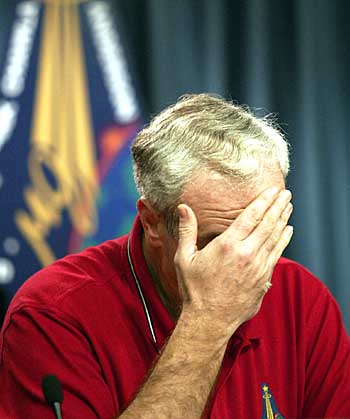NASA has officially contacted the US military and requested that in the future the shuttles be photographed regularly by intelligence satellites, in order to distinguish if there was a malfunction in them that required repair or that could cause the loss of the spacecraft upon landing

The US military agreed to a request submitted by NASA to take detailed and regular satellite images of the shuttles while they are in orbit. This is in light of the difficult question of why such photos of possible damage to the wing of the Columbia were not taken.
NASA head Sean O'Keefe said last Friday (28/3) that he reached an agreement with the National Mapping and Imaging Agency to use the agency's spy satellite "on necessary occasions" without NASA having to submit a specific request.
O'Keefe described the agreement in the following definition: "When you have an opportunity, please take it. We will use the photos to save lives, or we will sign them and send them back." The step is interpreted as a preventive measure of public relations against the hundreds of pages of NASA's internal documents, which are supposed to be published early next week.
Some of these emails, which have already been revealed to the investigative committee, describe several NASA employees requesting scanning images during the Columbia mission to determine whether the spacecraft could return safely.
Investigators believe that very hot air penetrated Columbia's left wing, which was damaged 81 seconds after launch by suitcase-sized pieces of foam that fell from the shuttle's external fuel tank.
The investigative team has already identified a weakness in the procedures and is pushing for better coordination between the space agency and the military offices responsible for the satellites and telescopes. O'Keefe told the investigative committee that he read those emails and they led him to several new lines of inquiry.
"Other emails that NASA intends to reveal this Monday describe arguments between engineers who fear damage to the insulation tiles, an excessively high temperature of the crew compartment, rust that appeared on the spacecraft and a fracture that was discovered in a component of the shuttle's fuel lines," said O'Keefe.
secrets kept
The agreement signed Friday will give NASA free or very low cost detailed photos of the shuttle during future missions, although it's not yet clear how useful the photos might be. The width of each of the delicate tiles is only about 8 centimeters, although this perhaps indicates the high capability of the satellites. The level of detail with which a satellite can photograph a moving shuttle nearby remains a military secret, but O'Keeffe, himself a former senior security official, said that the US's ability in this area: "is not similar to that described in Clancy's novels."
The agreement was drafted in a letter sent earlier this week from O'Keefe to Major General James Clapper, director of NIMA. NASA is still reviewing which of its employees will receive security clearance to see the sensitive images that the highly classified military satellites can take of the shuttle."
O'Keeffe described the number of employees who during the Columbia flight could see the images as no more than a single-digit number "and you'd still have more than the fingers of one hand left over."
Some NASA engineers argued during Columbia's 16-day flight that images of possible damage to the spacecraft's left wing could have helped decide whether the shuttle could return safely.
Before the disaster, NASA rejected an offer by the Mapping Agency to photograph the shuttles and NASA officials rejected an unofficial request for the Air Force telescope to photograph Columbia. O'Keeffe said that he did not enter into the discussion whether due to the sensitivity of the question of how the US spy satellites work. However, he admitted that there was quite an opportunity to take pictures of Colombia and this "was very convenient".
O'Keeffe said that he does not determine what decision he would have made if he had the photos that unequivocally prove that damage was done to Colombia.
"I never get involved in what-if questions," O'Keeffe said. "I want to see facts before I make or judge someone else's decision." O'Keeffe noted that NASA intends to reach a similar agreement with the Air Force so that it will photograph the shuttles with its powerful ground-based telescopes.
